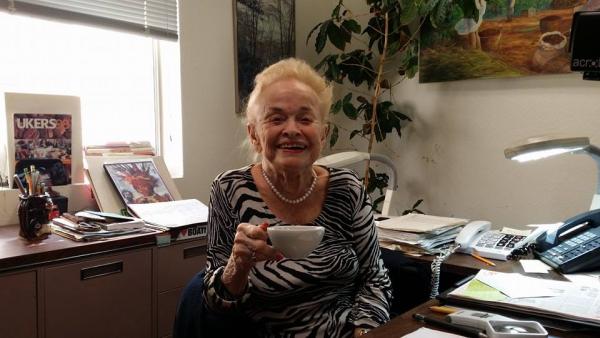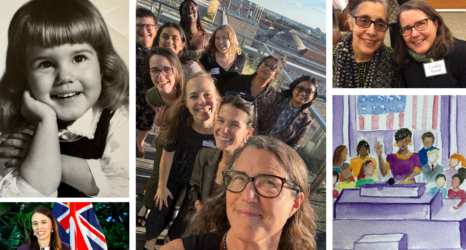If you enjoy coffee from your favorite local cafes, find joy in perfecting your pour-overs or find yourself talking to baristas about the single origin brews they’re working on, you may owe Erna Knutsen a debt a gratitude.
Knutsen played a vital role in shaping the way we drink coffee—and she smashed a number of glass ceilings during her time as a pioneer in the field.

Knutsen was born in Norway in 1921 and came to the United States as a child. When she was old enough, she entered the workforce, like most women her age did, by becoming a secretary. Eventually, she’d end up working for Bert Fullmer, a partner at B.C. Ireland, which was a major coffee importing business based in San Francisco.
In the 1970’s, when Knutsen was working for Fullmer, coffee was bought without much regard for quality. Big importers bought coffee by the container, and you didn’t really know too much about the coffee you were buying except its price.
One of the ways coffee is evaluated is through cupping, which is a blind tasting of various coffees. When Knutsen asked to join her male colleagues at the cupping table, she was told no. That singular moment marked a turning point in her career.
She recalled this experience at the 2014 Specialty Coffee Expo, where she was awarded her second lifetime achievement award. (She received the very first one ever awarded in 1991.) “Even though I was kept out of the cupping room and the roaster because I was a woman,” she delighted in telling the room, “I fooled them. I bought the company and I fired them all.”
After that, there was no stopping her. One of the stories passed around the coffee community over the years was about how she met a young man determined to sell a coffee from Sumatra called Mandheling, and she loved the coffee so much she convinced her boss to let her buy a container and sell it to roasters—which she did.
“Forget her gender, she was just a really good coffee person, and she had an appreciation for a couple of things,” shares Ric Rhinehart, the former head of the Specialty Coffee Association. At the time, coffees weren’t marketed the same way they are now—you couldn’t just buy a few pounds of coffee from a particular country, and most coffee traders were only interested in selling containers of coffee—37,500 pounds of coffee, or 250 bags, which is what you probably see when you look over at your local roaster pulling green coffee out of burlap sacks—to folks who could buy coffee in huge units. For Erna to want to buy just one container of coffee from a specific region—and then sell bags of coffee from that container to small roasters— was especially remarkable. She knew that there was a market for coffees in small lots that were better or distinct from the commercial lots that were trading around her. She knew intuitively that she could make a market for that and she pursued that market. And that was in itself the break off point for specialty coffee.”
This story—along with her firing all her male colleagues who didn’t believe in her—would eventually become the stuff of lore as Knutsen continued to establish her career as the founder of Knutsen Coffees. She coined the term “specialty coffee” in a 1974 issue of the Tea & Coffee Trade Journal, and continued to be one of the leading importers of truly remarkable coffees.
“She was a pioneer. She truly was about quality above and beyond anything else,” Keren Cebreos of Elan Organic Coffees said. “She sold the best [coffee] she could get her hands on.” Along with having a reputation for being a great coffee trader, Knutsen also had a reputation for being a fiercely shrewd and independent thinker.
“She was fascinatingly salty…she could be utterly irreverent,” shares Rhinehart. “She would say things that would just astound you from time to time, and probably more often than from time to time…she could be shocking and coy and absolutely direct all in the course of one conversation…she convinced lots of people of things they hadn’t believed before they talked about her.”
Knutsen never played by the rules, no matter where she went. She had a regular table at a place in downtown San Francisco called Jack’s, known then as a men’s club, and would invite new coffee professionals, many times women, to sit with her and share their stories. “She was very curious about me because I was so young, and I was at this table with these total rockstars,” shares Kayd Whalen, who is now a Senior Vice President for InterAmerican Coffee but got her start with Cebreos at Elan Organics.
Whalen remembers meeting Knutsen early in her coffee career. “She had a little lamp she was reading her menu with because it was super dark in there, and after we ordered she shone the lamp in my face and was like, ‘How did you get here? How did you get into coffee? Who are you? Tell me about you?’ So the fact that she was still interested in meeting new people and learning about the young people getting into the industry…made me feel like a part of something much bigger than the office.”
InterAmerican is “75 percent women,” which Whalen credits partially to the example Knutsen set. “It was a totally totally different world when Erna started in coffee,” Rhinehart says. And while there’s still a lot of work to be done in the coffee world—like professional cooking, many of the highest paid and most prestigious positions are held by white, cis, heterosexual men—Knutsen set a powerful example for how to upend the industry.
“She watched the unimpressive behavior of the men around her,” Rhinehart explains, “and thought, ‘wow, I could do this better than them.’”





